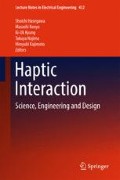Abstract
Most haptic devices have the common problem of requiring a large hardware setup, because they must present actual force. To cope with this issue, we have proposed a method to present force sensation using tendon electrical stimulation. In this paper, we investigated whether it is possible to present force sensation by electrically stimulating the tendon through the skin surface at the wrist. We also investigated the relationship between the amount of sensation and the stimulation parameters. We found that a force sensation can be generated by electrical stimulation to the wrist, and the direction of the force sensation is opposite to the motion elicited by muscle electrical stimulation. We also found that it is possible to control the amount of the sensation by varying both pulse height and pulse frequency.
Access this chapter
Tax calculation will be finalised at checkout
Purchases are for personal use only
References
Kaczmarek, K.A., Tyler, M.E., and Bach-y-rita, P.: Electrotactile haptic display on the fingertips: Preliminary results. In: Proceedings of the 16th International Conference on IEEE Engineering in Medicine and Biology Society, vol. 2, pp. 940–941. Baltimore, U.S.A (1994)
Kajimoto, H.: Electro-tactile display with real-time impedance feedback using pulse width modulation. Trans. Haptics 5(2), 184–188 (2012)
Taro, M., Hideyuki, A., Maki, S.: Virtual acceleration with galvanic vestibular stimulation in a virtual reality environment. In: Proceedings of IEEE Virtual Reality 2005, pp. 289–290 (2005)
Goodwin, G.M., McCloskey, D.I., Mathews, P.B.C.: The contribution of muscle afferents to kinaesthesia shown by vibration induced illusions of movement and by the effects of paralysing joint afferents. Brain 95(4), 707–748 (1972)
Eklund, G.: Position sense and state of contraction; the effects of vibration. J. Neurol. Neurosurg. Psychiatry 35, 606–611 (1972)
Jones, L.A.: Motor illusions: what do they reveal. Psychol. Bull. 103(1), 72–86 (1988)
Gandevia, S.C.: Illusory movements produced by electrical stimulation of low-threshold muscle afferents from the hand. Brain 108(4), 965–981 (1985)
Kajimoto, H.: Haptic interface using tendon electrical stimulation. In: Proceedings of the 9th International Conference on Advancement in Computer Entertainment, pp. 513–516 (2012)
Tamaki, E., Miyaki, T., Rekimoto, J.: Possessedhand: techniques for controlling human hands using electrical muscles stimuli. In: Proceedings of the 2011 Annual Conference on Human Factors in Computing Systems, pp. 543–552. Vancouver, Canada (2011)
Miyamoto, N., Aoyama, K., Furukawa, M., Maeda, T. and Ando, H.: Air tap: The sensation of tapping a rigid object in mid-air. In: Proceedings of Asia Haptics 2014, pp. 285–291 (2014)
Lopes, P., Ion, A., Baudisch, P.: Impacto: simulating physical impact by combining tactile stimulation with electrical muscle stimulation. Proceedings of UIST’15. (2015)
Acknowledgements
This study was supported by JSPS KAKENHI Grant Number JP25700020.
Author information
Authors and Affiliations
Corresponding author
Editor information
Editors and Affiliations
Rights and permissions
Copyright information
© 2018 Springer Nature Singapore Pte Ltd.
About this paper
Cite this paper
Takahashi, A., Tanabe, K., Kajimoto, H. (2018). Relationship Between Force Sensation and Stimulation Parameters in Tendon Electrical Stimulation. In: Hasegawa, S., Konyo, M., Kyung, KU., Nojima, T., Kajimoto, H. (eds) Haptic Interaction. AsiaHaptics 2016. Lecture Notes in Electrical Engineering, vol 432. Springer, Singapore. https://doi.org/10.1007/978-981-10-4157-0_40
Download citation
DOI: https://doi.org/10.1007/978-981-10-4157-0_40
Published:
Publisher Name: Springer, Singapore
Print ISBN: 978-981-10-4156-3
Online ISBN: 978-981-10-4157-0
eBook Packages: EngineeringEngineering (R0)

